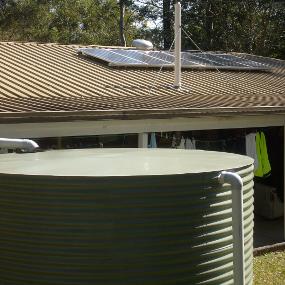Build it Back Greenbushfires
Rainwater
 The first
decision you have to make is where the tank will be located and
access.
The first
decision you have to make is where the tank will be located and
access.
If you have a large area with lots of space and easy access to get the tank in you will have a number of options.
Where you locate the tank (or tanks) will determine its size and shape, and possibly even its colour if it needs to blend into the surrounding vegetation or buildings.
The ideal size of your rainwater tank will depend on what you want to use the water for, the number of people in the household, and also your budget, roof size and rainfall.
Here is a rough guide for a 2-4 person home:
|
Use of water |
Tank size (litres) |
|
Garden (small - medium) |
5000 |
|
Toilet and laundry |
5000 |
|
Hot water |
10,000 |
|
Whole house |
15,000 |
|
Whole house & garden |
20,000 |
Non-combustible (metal, concrete) rainwater tanks are important in all bushfire zones.
Material sustainability
There are other factors that need to
be considered when looking for a tank. For a start, the tank will
eventually need to be scrapped, and you must consider what to do
with it at the end of its useful life.
Galvanised and lined mild steel tanks will generally be quite corroded by the time they start to spring leaks, so they may not be easy to dispose of. Stainless steel tanks generally don't corrode to the level that coated steel tanks do, so most scrap metal dealers will actually pay you for them. What's more, all of the material in a stainless steel tank can be recycled, whereas the zinc and/or plastic coatings of mild steel tanks are removed from the steel during recycling.
Poly tanks pose an interesting problem in that, if they have degraded to a point where they can no longer hold water, the plastic has reached a point where it can only be recycled into a limited range of other products. Unless the manufacturer/supplier has some sort of recycling system available for them, they will end up in landfill. Fibreglass tanks are generally not recyclable, and being a composite material will most likely end up as landfill.
Concrete tanks are fairly benign, but they do represent quite a large volume of materials. There are some companies now that can recycle concrete.
The toxicity of the material must also be addressed. Even if a metal tank ends up in landfill, it is a relatively benign material. Although Colorbond tanks have plastic coatings, these will eventually break down into various chemicals. The amount of toxicity per tank is small, but it is still there. Fibreglass tanks contain quite a lot of polyester resin and small amounts of some rather nasty substances, such as the catalyst used to make the resin set. This will all be released as the tanks break down in landfill.
The embodied energy of a material is another consideration. Stainless steel has quite a high embodied energy, but being fully recyclable offsets most of that. Steel is similar, but to a lesser degree.
Plastic and fibreglass tanks have more embodied energy than you might think. The actual volume of material in them is a great deal more than for a metal tank because they have much thicker walls.
The most common rainwater tank materials are plastic (usually polyethylene), metal and concrete. Polyethylene tanks are a popular choice for above ground tanks. They are durable and most can simply be installed onto a sand base or pavers, or even partly into the ground if needed. They typically come with at least a 10 year guarantee.
The iconic metal tank is typically corrugated metal with either a Zincalume or colorbond finish. Metal tanks need to be installed on a concrete base or reinforced pavers. They are typically guaranteed for at least 20 years and can be recycled at the end of their useful life. If you have a lot of space larger metal tanks from 25,000 to over 200,000 litres can be assembled onsite.
Concrete tanks are less common these days, but can be a good above or below ground option - and they are great for bushfire resilience. They can be prefabricated or constructed onsite. Bladder tanks are great for placing in previously unused space under floors. Some models are self-supporting and others are assembled on frames that sit between the rows of foundations under the house. The polymers used for the bladders are UV, puncture and rodent resistant, and some can be used for drinking quality water.
When building your home, consider how easily the plumbing for the house can be accessed so that rainwater tanks or greywater systems can be easily installed. Even better is to incorporate rainwater tanks at the design stage of your build. If possible, place your tanks on higher ground so that water can gravity feed as much as possible. Tanks do not need to be placed directly next to the house. A system of wet pipes can be used to take water from tanks further away on the property.
There are a range of accessories that are needed to ensure that the water collected in your tank is free from contaminents, especially debris from your roof and gutters. Gutter guards or special gutters with filters can be used to prevent leaves and debris entering the guttering. An alternative to gutter guards are leaf diverters that are mounted on the downpipe and typically consist of a mesh screen angled to deflect leaves, but that allows water to flow through into the downpipe. First rain diverters are used to divert the first bit of rain away from the rainwater tank along with any accumulated contaminants from the roof or guttering.
To use rainwater in the garden you can simply run a hose from the tank, but the flow rate will not be very fast. To get similar flow rates to mains water add a pressure pump. In choosing a pump you need to consider the number of taps that are likely to be used at once, the height and distance you need to pump water, the noise of the pump, and the price.
This is especially important when plumbing rainwater to the house and should be discussed with your plumber and/or tank stockest. One of the best tricks for avoiding both high energy use and high levels of noise from your pump is to place a header tank (small tank) next to the house. Water can then pump from the main tank(s) to the header tank when it empties rather than the pump starting up every time you turn on the taps in the house.
To use rainwater in the house, plumbing connections will need to be made to the pipe network either at an incoming point or at different points of the house. You will need to get a licensed plumber to make these connections, and authorised backflow prevention devices will need to be used where connections are made with mains water pipes.
State and local government planning and building regulations need to be taken into account before installing a rainwater tank. Rainwater tanks should be of an adequate size with a pump and fittings that conform to Country Fire Authority requirements.
For people whose homes were destroyed in the 2009 Victorian bushfires there are state rebates of
$1000 for a 4000-litre or more rainwater tank connected to all toilets and laundry, a $900 rebate for a 4000-litre or more tank connected to all toilets and $500 for a tank of 2000-3999 litres connected to all toilets (connection to laundry optional).
Suppliers
Action Tanks - www.actiontanks.com.au
Ph. 0448 42 42 52
All Poly - www.allpoly.com.au
Ph. 1300 255 765
Aquasource - www.silvanh2o.com.au
Ph. 1300 745 826
Aquaworks - www.aquaworks.com.au
Ph. 03 9873 1422
Bluescope Water - www.bluescopewater.com.au
Ph. 1800 654 774
Downpour - www.downpour.com.au
Ph. 1300 664 148
PJT Green Plumbing - www.pjtgreenplumbing.com.au
Ph. 1300 731 578
Stratco - www.stratco.com.au
Ph. 03 9409 9200
Tank World - www.tankworld.com.au
Ph. 1800 68 69 70
Team Poly - www.teampoly.com.au
Ph. 1300 658 961
Wet Earth - www.wetearth.com.au
Ph. 02 6062 3300
WaterStore Poly Tanks - www.waterstore.com.au
Ph. 1800 654 610
Listed suppliers are a guide and are not endorsed by Green Cross Australia or the Alternative Technology Association.


